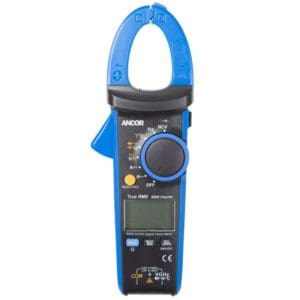by Bill Morris

Arriving at our next port successfully depends, in great measure, on properly functioning electronic navigation and communication systems. And maintaining those systems in tip-top condition requires dependable test equipment, most notably a high-quality multimeter.
Surprisingly, many cruising vessels carry no more than a current tester consisting of two wires and a sealed lightbulb to demonstrate the presence of current — how much is anyone’s guess. Some skippers rely on a small, inexpensive battery tester with color bands: green for good, yellow for so-so and red for replace.
Properly prepared skippers, on the other hand, equip their vessels with durable, drop-resistant, water-resistant, highly accurate multimeters suitable for the offshore sailing yacht. With this indispensable tool, you will be able to detect voltage drops, alternator charging power, battery charge and circuitry within your electronic communications and navigation systems.
A high-quality multimeter is designed to measure amperage, voltage and resistance (ohms) precisely. Until recently, the Fluke series of electrical testing units, known for their yellow rubber jackets, were virtually the only choice for the offshore sailor. Today, there are numerous well-constructed multitesters up to the demands of ocean cruising, and most are well within the budget of the cost-conscious cruiser.
The Ancor 8-Function Digital Multimeter, available at West Marine and other chandleries, is a well-built yet affordable tool with an LED screen and the standard two leads for electrical measurement. The Ancor 12-Function Wrap Around Meter with RMS (root mean square) measures electrical activity without the need of wire leads (AC current only). And its backlit OLED screen permits reading in poorly lit corners of your vessel, such as the engine and battery compartments.
The Sperry DM6650T True RMS Digital Multimeter is a rugged, professional electrical tester capable of reading current up to 10 amps AC/DC. The unit is water resistant and drop proof to 10 feet. At roughly $200, the DM6650T is not exactly cheap but still quite reasonably priced for the quality it offers.
The Extech EX505 Heavy Duty, Autoranging Digital Multimeter is an industrial, waterproof, drop-resistant device capable of measuring AC/DC voltage (1,000 volts), current (10 amps), resistance (40,000 ohms) and capacitance (100 microFarads). Additionally, this unit includes a Type K temperature probe which measures from 4 to 1,382 degrees F.
Along with the temperature probe and standard pair of test leads, the EX505 comes with a magnetic hanging strap, carrying case and nine-volt battery. Not a bad choice, especially when you consider a price tag of around $100.
Another good value is the Klein ET250 AC/DC Voltage/Continuity Tester, which measures up to 600 volts AC/DC and may be used to test the function of GFCI-protected circuits and electrical outlets. On my 1966 Cal 30 Saltaire, AC electrical outlets are GFCI-protected to protect both vessel and crew — I recommend you ensure the same for your floating palace.
An interesting feature of the ET250 is its test connections, which are inserted into the base of the unit rather than the face, permitting easier storage in a tightly packed tool box. The ET250 is drop-proof to 9.8 feet and rated IP53 dust/water resistant. At roughly 50 bucks, this device offers a lot for very little.
And, of course, we have the venerable line of Fluke multimeters, which are generally regarded among electricians as top of the line. The Fluke 28II is fully waterproof and impact resistant up to a 10-foot drop, ideally suited for the offshore yacht. It also floats when stored in its yellow rubber holster. The Fluke 28II measures up to 1,000 volts AC and DC, and up to 10 amps (20 amps for 30 seconds).
Running on three AA batteries, the Fluke 28II boasts “backlit keypad buttons, large display digits and two-level bright white display backlighting for easy visibility in low-lit areas.” The unit sells for about $600, which is significantly higher than other devices in its class but well worth the expense if you want the ultimate in dependability.
Find a multimeter that fits your needs and budget, and you will sail with greater confidence in the electrical soundness and safety of your vessel.
Circumnavigator-author Bill Morris believes the best strategy for succeeding as an offshore voyager is to keep systems simple and, if possible, manual. Key to survival are a windvane self-steering system, a basic array of electronics and an aggressive alternative energy battery charging matrix. Bill is an Ocean Navigator contributing editor and the author of The Windvane Self-Steering Handbook (International Marine, 2004) and The Captain’s Guide to Alternative Energy Afloat (Seaworthy Publications, 2019).
